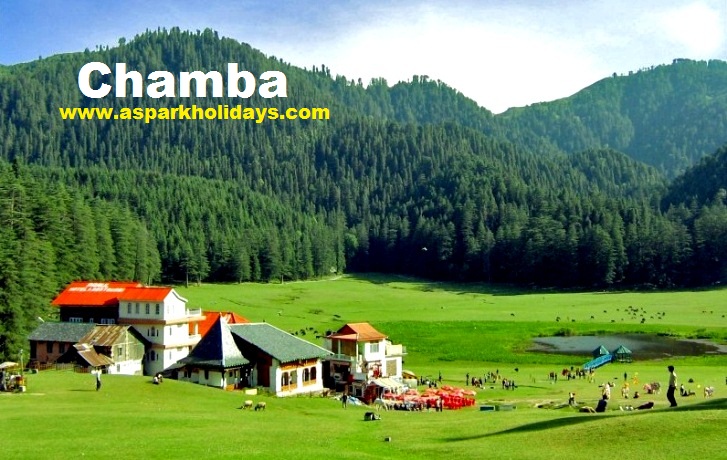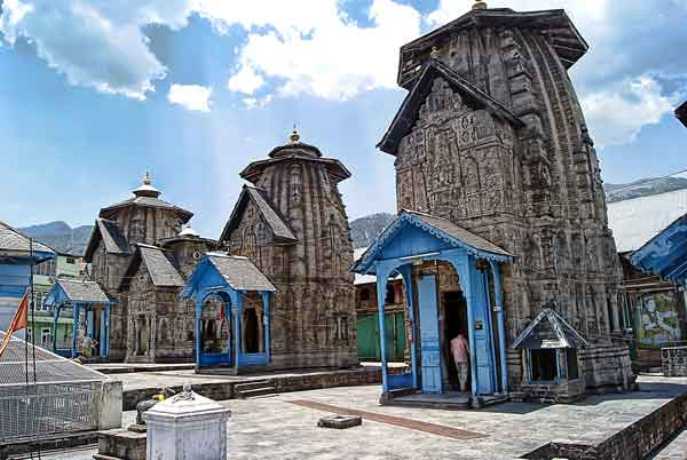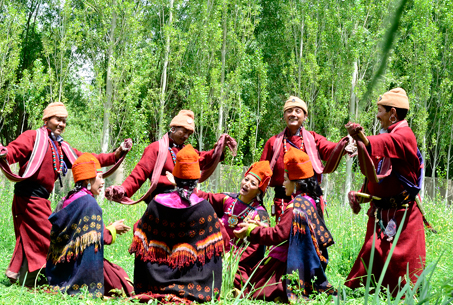
Chamba, the valley of milk and honey is known for its streams, meadows, temples, paintings, rumal ( handkerchief ) and lakes. Chamba has few rivals for its scenic beauty. Chamba is situated at an altitude of 926 metres. and spreads in the area of 24 km. There are three well defined ranges in the district - The Dhauladhar range, the Pangi or Pir Panjal range and Zanskar range. Located on the banks of the Ravi river the township resembles an Italian village fortress. Chamba's temples are mostly dedicated to Lord Shiva and Vishnu and are built of richy engraved stone. The town is also the base for Gaddi shepherds who, though nomadic in their way of life, return to Chamba periodically to stock supplies. Chamba is so sheltered by snow-clad mountain barriers that its monuments escaped destruction at the hands of invaders, which is why it still remains one of the best preserved heartlands of the Himalayan arts.
Bhuri Singh Museum : Bhuri Singh Museumis one of the oldest museums in India. It was set up in September 1908 by the Raja Bhuri Singh under the guidance and inspiration of venerable historian of Indian Art Professor John Philip Vogel. It is on the world art map because of its finest collection of Pahari miniature paiting chieflu Chamba and guler Kangra styles. Apart from the paintings, the museum houses a large collection of epigraphs, copper plates, historical documents, manuscripts, sculptures in stone, metal and wood, Chamba rumals, coins, murals, wood carvings, armour and other decorative arts. Opens daily from 10:00 A.M. to 5:00 P.M. except on Monday and gazetted/local holidays. Lunch time is 1:30 P.M. to 2:00 P.M. It is also open on Sunday.
Temples : Chamba has numerous ancient temples patterned in the style of local hill architecture, as well as Shikhara temples. The main groups of of these temples, Lakshminarayan, as well as most in the region are dedicated to Lord Shiva and Vishnu, built in the period between the 8th and 10th centuries A.D. The 'Chaturmukhi' image is a major highlight at the Hari Rai Temple. Some other important temples of Chamba are the Bansi Gopal temple, Shri Bajreshwari temple and Chamunda Devi temple. There is also a shrine dedicated to the memory of Rani Suhi who, as the legend, sacrificed herself, so water could to the town Chamba.
Chamab Chaugan : A public promenade - a grassy maidan less than 1 km. in length and about 75 metres wide. It is a busy local trading centre for villagers from the surrounding hills. Each year Chaugan is the site for the Minjar procession ( Minjar Mela ). The fair lasts for a week and people attend the fair in the Minjar procession. The fair lasts for a week and people attend the fair in the local customs and colorful dresses, in a gay mood walking in the Chaugan where a large number of sports and cultural activities take place to commemoratethis occasion. On the conclusion of fair the "Minjars" are immersed into the Ravi river. It is also an establishment base for various exciting treks into the valley around.
Chamba Town : Located on the banks of the Ravi river the township resembles an Italian village fortress. The weather of Chamba is always pleasant, not too cold and not too hot because of its typical height of 1006 meters from mean sea level. A gentle cool breeze is refreshing the whole town at intervals. There are many famous places around Chamba Town. Chamba is known for its streams, meadows, temples, paintings, rumal ( handkerchief ) and lakes. Chamba Town sometimes experiences snowfall during winter that adds to the beauty of Chamba Town. The people of Chamba are very helpful and innocent. Chamba Town is also the main market for many villages from near and far.
Laxmi Narayan Temple : Laxmi Narayana Temple, which is the main temple of Chamba town was built by Sahil Varman in the 10th century AD. The temple has been built in the Shikhara style. The temple consists of Bimana i.e. Shikhara and GarbhGriha with a small antralya. Laxmi Narayana Temple has a mandapa like structure also. The wooden Chhattries, the shell roof, atop the temple were in response to the local climatic conditions as a protection against snowfall. There are several other temples within the complex. The temple of Radha krishna, Shiva Temple of Chandergupta and Gauri Shankar Temple are among these.
Chamunda Devi Temple : This temple is located on the spur of the Shah Madar Hill overlooking the town to its south east. The temple stands on a raised platform. The temple has artistic carvings on its lintel, pillars and the ceiling. Behind the main temple is a small shrine of Lord Shiva in the Shikhara style. There is another platform in front of this temple where two very old peepul trees provide shelter to the visitors. From this platform a bird's eye view of most of the land marks in the town including Chaugan, Circuit House, most of the temples and river Ravi can be had. The temple is being looked after by Archaeological Survey of India. This temple can be approached by road from Chamba ( 3 km. ). The temple is an ideal picnic spot throughout the year because it has an easy approach and a commanding view.
Hari Rai Temple : This temple is dedicated to Lord Vishnu and dates back to 11th century. It was probably built by Salabahana. This temple lies in the north-west corner of the main Chaugan, which had became the official entrance to the town by the end of 19th C. A steep path leads to the old Shitla bridge, which was constructed in the year 1894. The temple is built in Shikhara style and stands on a stone platform. The Shikhara of the temple is finely carved. This is one of the major old temples, which is away from the old township and the only one near the Chaugan.
Chamba Church : Situated in the main Chamba market is the beautiful Chamba Church. This Church was erected by Raja Sham Singh and gifted to the church of Scotland mission for the use of the christian community in Chamba. Its foundation stone was laid on 17th February, 1899 A.D. and its work was finished in 1905 A.D.
Chamba Library : Inside the Government College of Chamba is the old Chamba library. You can find books on almost every topic of Himachal Pradesh here, i.e. Himachal history, geography, states, books explaining ancient art and culture along with photographs of ancient coins, armour etc. If you are interested in the monuments, manuscripts, ornaments, wooden articles of utilities etc., found in the Bhuri Singh Museum, then you must visit Chamba Library. Here you can find truck loads of books on these topics. There is also an office situated near the library and you can find various books on other topics here. And not to mantion, you can also find mystery-thriller and adventurous novels of various writers here.
Sui Mata Temple : According to a legend, the Chamba town had no convenient water supply. And therefore the Raja had a water course made from the Sarohta stream, but somehow the water refused to enter the channel made for it. It was ascribed to supernatural causes. The Saints advised that the spirit of the stream must be tranquilized and victim must be either Rani ( Queen ) or her son. The Rani named 'Naina Devi' got ready to sacrifice herself. Accompanied by her maidens and bare-headed as for 'Sati', she was taken to the spot near the village of 'Balota', where Rani was buried alive. The legend goes on to say that when the grave was filled in, the water began to flow and has ever since flowed abundantly. A shrine was constructed at the top of thehill by Raja in her memory. A fair called 'Suhi Mela' is also held in her memory from 15th of Chait to the 1st of Vaishakh, where only women and children are allowed to participate.
Bharmaur : ( 2,195 metres ) 65 km. ) Bharmour was the original capital of the state of Chamba. It has several ancient temples and monuments that reflect its erswhile glory. Some of the important temples are of - Manimahesh, Lakshna Devi, Ganesh and Nar Singh. This region is also home to Semi-nomadic Shepherds, the Gaddis. Once called Brahmpura, still retains its 84 ( Chaurasi ) ancient temples and the monuments of its one time glory, some of which date back to the 7th century A.D.
Chaurasi Temples : The main complex have temple of Lakshana Devi, Ganesha, Manimahesh and Narsingha. According to a legend, 84 Yogi's visited Bharmaur during the region of king Sahil Verman. Pleased with the king's humanity and hospitality, the yogis blessed the king with ten sons and a daughter Champawati. The temples dating back to the 9th century, are one of the most important early Hindu Temples in Chamba valley. The distant of 65 km. from Chamba to Bharmaur is covered by road. Special buses ply only during Chhari Yatra days in September.
Lama Dal : Held sacred to Lord Shiva, this lake lies amidst bare rock. 'Lama Dal' means a long lake. It is in the inner slopes of Dhauladhar range. This is a group of seven lakes, the largest of all is Lama Dal. It is 20 km from Dainkund (Dayankund). It is said to have unknown depth.
Pangi Valley : This range of the Himachal in the Mid-Himalaya called Pir Panjal by geologists and Pangi Range by common people. It is the direct continuation of the main Himalayan axis entering the Himachal on the East of Bushahr. After dividing Kullu from Lahaul-Spiti, it enters Chamba territory on the Western border of Bara Banghal and traverses the district for more than sixty miles. This range divides Chamba into two unequal sections and separate these from each other to such an extent that even in the summer there is comparatively little inter communications. The Northern or smaller section called Pangi and Chamba-Lahaul, is then completely isolated from the outer world.
Need Aspark Help?
For Tour Packages, Vehicle Rental and Customer Care Support.
+91 9999 31 7846
booking@asparkholidays.comWhy Travel with Us?

Excellent Support
Our Team Available 24x7 for Customer support
Best Price & Savings
We Offer the Most Competitive Prices.


